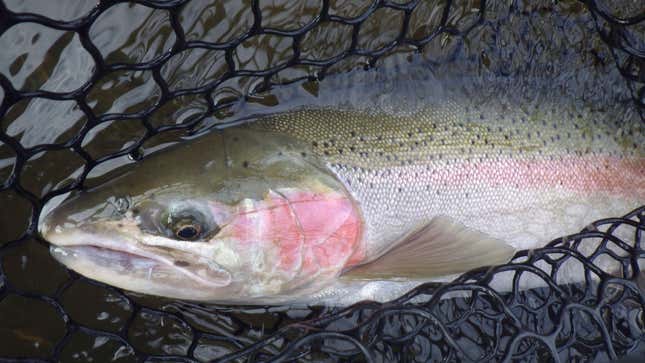
One possible answer to the growing plastic problem could come from a weird place: salmon jizz. In a study published recently in the Journal of the American Chemical Society, a team of researchers from China detail how they’ve created what they call “DNA plastics,” a plastic material made from strands of DNA.
To create the new material, researchers extracted DNA from salmon sperm and mixed it with chemicals from vegetable oil to create a gel-like substance. That substance can then be formed into a mold and freeze-dried. Researchers in the study used this process, which they call “aqua-welding,” to produce a bunch of little tchotchkes, including a mug, a model of a DNA molecule, and some puzzle pieces. The mug, frankly, looks like something made from sperm and isn’t going to win any design awards anytime soon.
Recycling this particular plastic is easy: A special enzyme can digest the DNA to break it down, or it can be dunked in water to turn it back into a gel. (That, incidentally, also means the mug might not be the best use of this particular plastic technology.)
In addition to being easily broken down, an added bonus of this new material is that its carbon footprint is much lower than traditional plastic since it doesn’t require any heat. The salmon spunk plastic uses about 5% of the energy that it takes to make regular plastic. Plastics made from biological materials like cornstarch have much lower emissions over their lifetime than regular plastics made with petrochemicals, but still need heat and energy to create, meaning producing them on a fossil-fueled grid is still a major problem for the climate. There are also other issues with traditional bioplastics, including recyclability, that make them less-than-great solutions in our current waste management system.
“To the best of our knowledge, our reported DNA plastics are the most environmentally sustainable materials of any known plastics,” Dayong Yang, a researcher at Tianjin University who led the study, told the Times of UK.
The new bioplastic, researchers say, isn’t dependent on fish jizz; you can use almost any organic material. But there are some big caveats to the dawn of the jizz plastic age, including the pretty problematic hurdle that it needs to stay dry in order to retain its shape. To actually use that salmon cum mug the researchers made, you’d need to coat it with a waterproof layer of other plastics of PFAS. That would make it much harder to recycle. It’s probably better in its unadulterated form, researchers say, for stuff like packaging and certain electronics that won’t get wet.
But even making little dents in the ways we use plastic can go a long way. There are now around 6.3 billion tons of plastic trash in the world, making its presence known from the oceans to national parks to the peak of Mount Everest. Plastics take so long to break down that they essentially exist outside of our human perception of time itself. Despite this, the fossil fuel industry is scrambling to find new uses for its product in the face of the energy transition, and investing heavily in the plastic industry. The world is set to triple its consumption of plastic by 2040. If using fish spunk puzzle pieces will help chip away at the quickly growing and mammoth problem of fossil-fueled plastics, count me in.